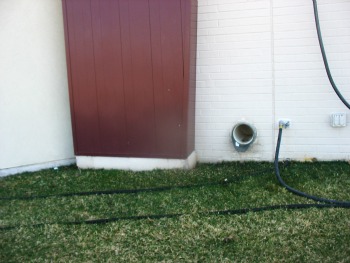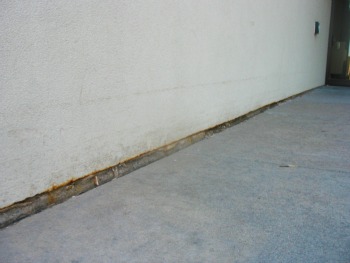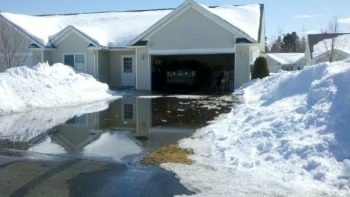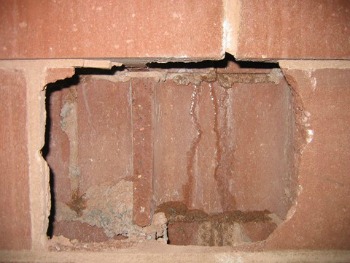Troubling shooting water infiltration is one of the most common issues we assist with here in the building technology department. When thinking of water seeping into a building, we often think of roof leaks. After all, a roof leak is easy to spot: a drip here, a discoloration on the ceiling there. But it’s the leaks we may not notice that can do the most damage. These tend to lurk within a building’s envelope (i.e., the outer elements of a building, from the roofing down to the surrounding pavement).
When air temperatures drop at night, any water that has seeped into a building’s envelope can go through a freeze-thaw cycle, wreaking havoc in the form of cracks and spalling, which is when concrete crumbles into small pieces. And this, of course, is where the nightmare begins.

1 – Soil sloping toward building
Never a good thing, especially if the soils under the building are comprised of a popular fill material: nice, clean sand. Because the backfill sand tends to create a “bathtub” under the building, giving any errant water a place to hang out and start causing problems under a building’s floor slab or in the building’s foundation.
2 – Water pooling on a sidewalk or against a building wall

There are several reasons why this can happen: A roof drain downspout could be pouring out in the wrong place, or a snow bank could have been piled up against a building. Regardless, when water sits against a concrete block wall or foundation, it seeps into the concrete (concrete is permeable). As the wall warms up, the water can move around as vapor and make its way up into the wall. Then, when nighttime temperatures come along, the water condenses and could seep into interior wall treatments or exterior paint/coatings, or it could freeze, which is very detrimental to the concrete (think pavement potholes).
3 – Snow and/or ice covering up catch basins 
This is a fairly obvious issue, and it happens when run-off re-freezes. When things begin to warm up, the snowmelt isn’t able to escape, and it will often find its way back toward a building, such as in the photo above. When water freezes next to a building, the resulting glacier essentially submerges a wall that is not designed to be under water. As you can imagine, that’s not ideal.
4 – Water sitting on a wall
Water hitting an exterior wall should run straight down to the ground without a reason to pause. But certain architectural features, such as raked/protruding joints in masonry and even windowsills, can cause water to pool at certain spots on the wall. This becomes an issue when winds push the water into the building.
These are just a few of the telltale signs that water may be working its way into your building. If you’re constructing a new building, don’t skimp on drainage. Some owners find this tempting because they think no one will notice, but water ponding around your building will be impossible to ignore when the next spring thaw arrives. And trust me, it’s never a cheap fix.
– Bill Bloemendal, PE
For more information about our Building Technology Department and Services, please visit: /services-delivered/building-forensics/

